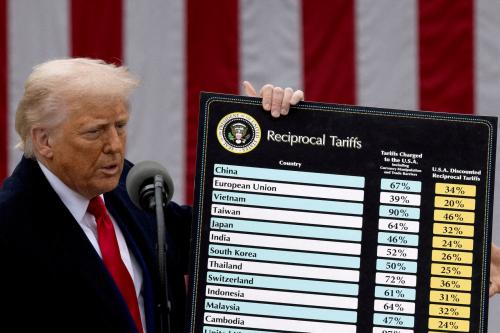President Obama is right to keep at it in Afghanistan, argues a new policy brief by Michael O’Hanlon, senior fellow and director of research for the Brookings Foreign Policy program.
Some have criticized the president’s decision to maintain a significant troop presence there (5,500 troops), instead of following through on the planned military withdrawal. But Afghanistan remains very important to American security, O’Hanlon contends, and the situation in the country is far from hopeless in spite of recent setbacks. We should reinvigorate American efforts in Afghanistan, he argues—not returning to levels seen in previous years, but ramping up somewhat from our current posture.
O’Hanlon calls Obama’s resolve in Afghanistan commendable, but writes that he and his administration are still making mistakes on U.S. policy toward the war-torn country. He advises that Washington make two specific changes to its military strategy in Afghanistan:
- Allow U.S. and NATO airpower to target the Islamic State and the Taliban (currently, they can only fight those groups if directly attacked). The narrow rules of engagement constraining foreign forces were intended to push Afghan armed forces to defend their territory themselves. While a worthy goal, O’Hanlon says, these rules often prevent us from attacking ISIS (though the targeting strategy towards the group may be changing) as well as the Taliban. They also impose unrealistically high demands on Afghan forces and make too fine a distinction between an array of aligned extremist groups operating in the country.
- Expand U.S. force presence from the current 5,500 troops to around 12,000 for a few years. In O’Hanlon’s opinion, our current numbers are not enough to work with fielded Afghan forces, and skimping on ground forces has contributed to security challenges in places like Helmand, for instance, which experienced new setbacks in 2015. More broadly, leaders in Washington and Brussels should stress the value of a long-term NATO-Afghanistan partnership, rather than emphasizing an exit strategy. This will signal Western resolve to the Taliban and other groups. While the next commander in chief should set the United States on a gradual path toward downsizing American troops in Afghanistan, he believes it would be a mistake for Obama to do so in the short term.
The long haul
O’Hanlon also argues that the United States needs to take a longer-term perspective on key political and economic issues in Afghanistan. On the economic front, there seems to be little thinking about an agricultural development plan for Afghanistan, associated infrastructure support, and land reform, among other challenges. On the political front, conversations often tend to focus on shorter-term issues like organizing parliamentary elections, reforming the Independent Election Commission, or modifying the current power-sharing arrangement. In the process, conversations about foundational political strategy focusing on Afghan institutions and the health of its democracy get short-changed. The parliament is in need of reforms, for instance, as is the political party system (which should encourage Afghans to group around ideas and policy platforms, rather than tribes and patronage networks).
O’Hanlon concludes that the situation in Afghanistan today, while fraught, is understandable given the Taliban’s resilience and NATO’s gradual withdrawal of 125,000 troops. We should not be despondent, he writes—rather, we should identify specific strategies that can help improve the situation. At the end of the day, Afghans must make the big decisions about the future of their country. But as long as the United States and its partners are still providing tremendous resources—and as long as security threats emanating from South Asia continue to threaten the United States—leaders in Washington should use their influence wisely.
The Brookings Institution is committed to quality, independence, and impact.
We are supported by a diverse array of funders. In line with our values and policies, each Brookings publication represents the sole views of its author(s).




Commentary
The case for reinvigorating U.S. efforts in Afghanistan
January 21, 2016